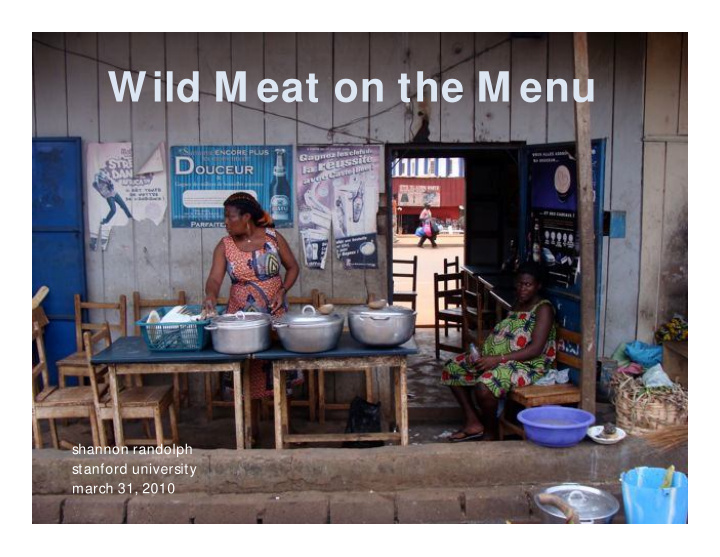



Wild M eat on the M enu shannon randolph stanford university march 31, 2010
Outline • Why did I do this study? • How did we collect the data? • What did we find in the markets and restaurants? • How can we make use of this for conservation purposes?
How to M easure Urban Wild M eat Demand? • M ap 185 eating establishments and major markets; track sources of meat to an urban center • Internal and independent informants collect 3000 weekly client and sales observations over 12 months in major urban wild meat markets • Conduct 150 in-depth interviews with restaurant clients in representative sample of restaurants
Top Ten Animals Reported Sold in 2009
Observations Recommendations • M arkets are not the primary Class A species issue but this should not indicate that networks aren’t based in these markets. • Yaounde bushmeat restaurants have increased by 33% since 2000. • Complicity of law enforcers calls for independent monitoring of law enforcement. • Increased but weak law enforcement paired with improved telecommunications results in viral like growth of wildlife trade.
Recommendations to Recommendations Reduce Illegal Urban Trade • Work with Government : – Amend wild meat collection permitting law to incentivize Class C species traders into regulated realm: 125,000 f/ CFA for Class C species 250,000 f/ CFA for Class B and C species – Issue permits with unique seal to discourage illegal permitting beyond quotas. – Conduct 10 strategic, randomly-timed market and restaurant raids aimed to prosecute illegal Class A and B trade and unpermitted Class C trade. – Institute incentives program to award law enforcers bringing wildlife offenses to prosecution. – Initiate three strikes penalties rule for businesses (e.g. CAM RAIL, bus agencies) transporting wildlife parts and meat.
Recommendations to Recommendations Reduce Illegal Urban Trade • Outsource : – Establish nodes in urban areas to inform about illegal large-scale traders and Class A in particular. – Conduct long-term monthly independent monitoring of urban trade through informants and anonymous leads. – Support already successful, independent private investigations of Class A species meat, live animal and trophy trade.
Recommendations to Recommendations Reduce Illegal Urban Trade • Employ Business strategies: – Place billboards and posters in public places of each Class A animal and legal consequences of selling these. – Establish and advertise an anonymous hotline to report information regarding illegal or corrupt trade/ related wildlife law enforcement. – Pair promotional give-away program at city entrances with discreet private car monitoring and prosecution program.
Recommendations to Recommendations Reduce Illegal Urban Trade • Fund Research: Support Cameroonian and international student research in business, social and natural sciences to: • Test DNA of meat in markets to accurately identify animals sold and compare to stated meat sold • Study non-consumptive and non-economic uses of rare animals for political or social gain (Political Science student at U Yaounde I currently undertaking this study)
Thank you to my research assistants, welcoming market informants, Cameroonian experts, NSF and Fulbright.
Recommend
More recommend